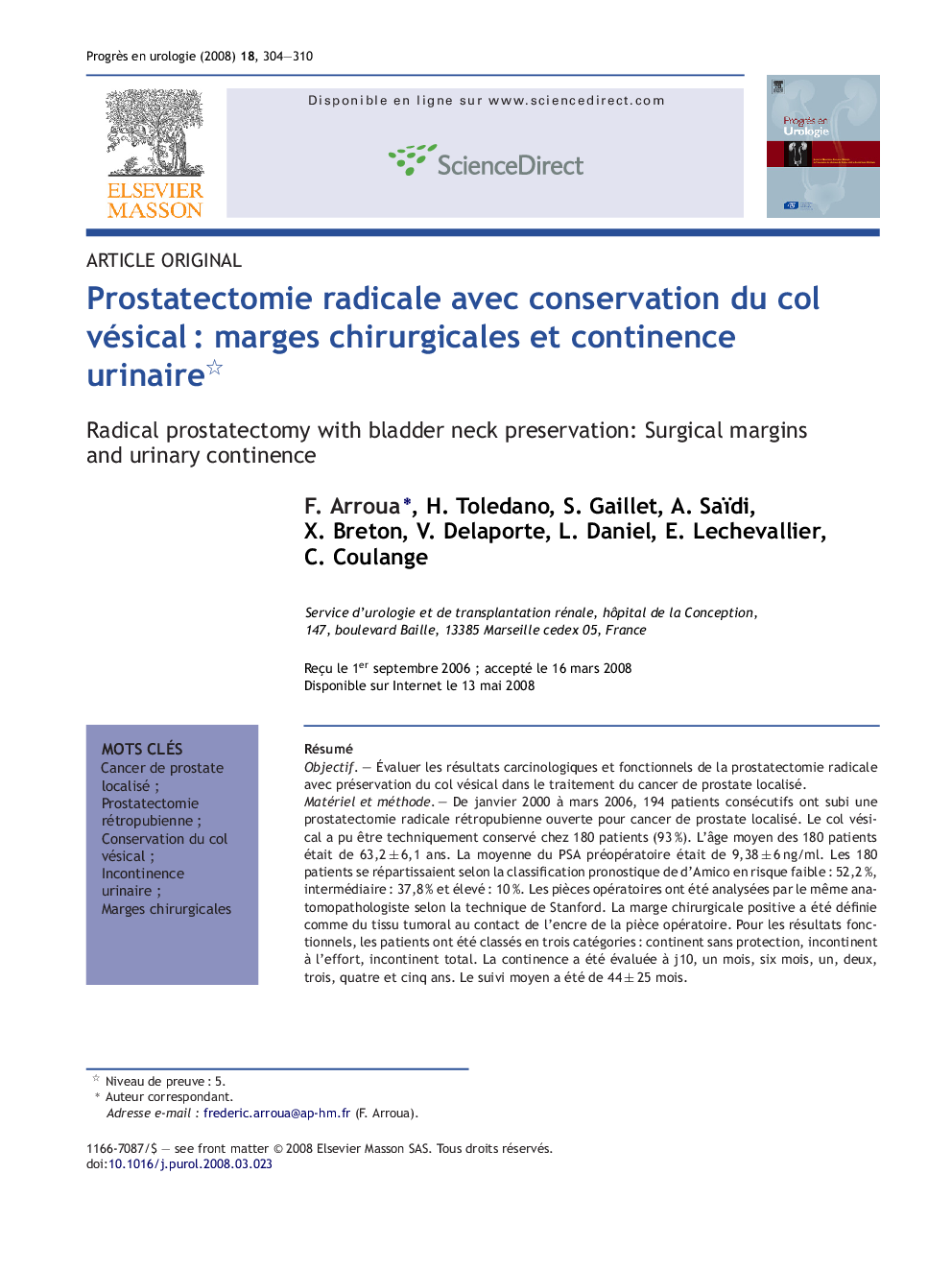| Article ID | Journal | Published Year | Pages | File Type |
|---|---|---|---|---|
| 3824128 | Progrès en Urologie | 2008 | 7 Pages |
RésuméObjectifÉvaluer les résultats carcinologiques et fonctionnels de la prostatectomie radicale avec préservation du col vésical dans le traitement du cancer de prostate localisé.Matériel et méthodeDe janvier 2000 à mars 2006, 194 patients consécutifs ont subi une prostatectomie radicale rétropubienne ouverte pour cancer de prostate localisé. Le col vésical a pu être techniquement conservé chez 180 patients (93 %). L’âge moyen des 180 patients était de 63,2 ± 6,1 ans. La moyenne du PSA préopératoire était de 9,38 ± 6 ng/ml. Les 180 patients se répartissaient selon la classification pronostique de d’Amico en risque faible : 52,2 %, intermédiaire : 37,8 % et élevé : 10 %. Les pièces opératoires ont été analysées par le même anatomopathologiste selon la technique de Stanford. La marge chirurgicale positive a été définie comme du tissu tumoral au contact de l’encre de la pièce opératoire. Pour les résultats fonctionnels, les patients ont été classés en trois catégories : continent sans protection, incontinent à l’effort, incontinent total. La continence a été évaluée à j10, un mois, six mois, un, deux, trois, quatre et cinq ans. Le suivi moyen a été de 44 ± 25 mois.RésultatsSur les 180 pièces opératoires, il y a eu 64 (35,6 %) marges chirurgicales positives et 112 (62,2 %) pT3. Il n’y a eu aucune marge positive au col, ni isolée, ni associée à une autre localisation de marge. À j10 et un mois, 71 % des patients étaient continents, 85 % à six mois et 89 % à un an. Il y a eu deux sténoses anastomotiques (1,2 %).ConclusionLa conservation du col vésical lors la prostatectomie radicale rétropubienne ouverte permet une continence précoce dans plus de 70 % des cas, sans augmenter le risque de marge chirurgicale positive.
SummaryObjectiveTo evaluate the functional and cancer results of radical prostatectomy with bladder neck preservation in the treatment of localized prostate cancer.Material and methodFrom January 2000 to March 2006, 194 consecutive patients underwent open retropubic radical prostatectomy for localized prostate cancer. The bladder neck was technically preserved in 180 patients (93%). The mean age of these 180 patients was 63.2 ± 6.1 years. The mean preoperative PSA was 9.38 ± 6 ng/ml. The 180 patients were classified according to the Amico prognostic classification as low risk: 52.2%, intermediate risk: 37.8% and high risk: 10%. Operative specimens were examined by the same pathologist according to the Stanford technique. Positive surgical margin was defined as tumour tissue in contact with the ink of the operative specimen. For analysis of the functional results, patients were classified into three categories: continent without protection, stress incontinent, totally incontinent. Continence was evaluated at D10, one month, six months, one, two, three, four and five years. The mean follow-up was 44 ± 25 months.ResultsThis series of 180 operative specimens comprised 64 (35.6%) cases of positive surgical margins and 112 (62.2%) pT3 cancers. No positive margins were observed in the bladder neck, either alone or associated with another positive margin. Seventy-one percent of patients were continent on D10 and at one month, 85% were continent at six months and 89% were continent at one year. Two cases of anastomotic stenosis were observed (1.2%).ConclusionBladder neck preservation during open retropubic radical prostatectomy allows early continence in more than 70% of cases without increasing the risk of positive surgical margins.
